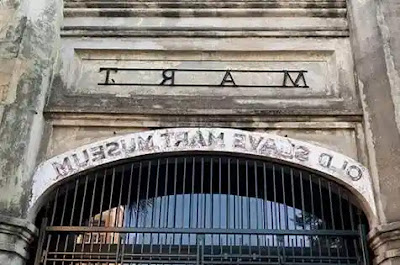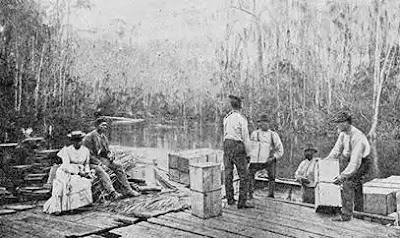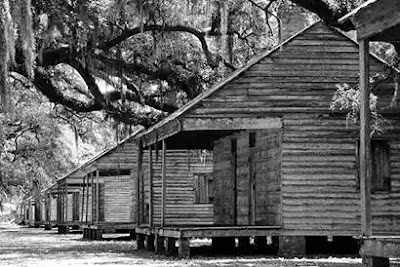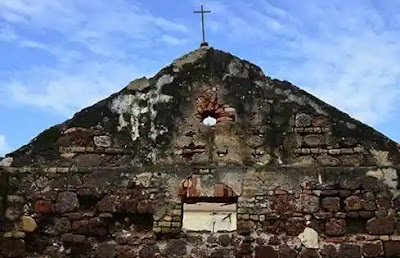the documentary explores American slavery and tells the matter of enslaved
and also how they survived because it's not exactly a light documentary. But "the Peculiar Institution" is much more varied than your history teacher has ever let on.

All Southerners Owned Slaves

In actuality, most people in the South did not own slaves. Despite state-by-state variations in data, the 1860 census identifies South Carolina and Mississippi as the two states with the greatest rates of slave ownership, with 49 and 46 percent of the state's population being European, respectively.[1]
However, the South's political system completely included slavery. Slavery was only permitted in Texas from 1845 until 1865. But by 1860, 182,566 slaves were held by 27% of Texans. The state's wealth and 68 percent of the government seats were held by that 27 percent. Slavery succeeded to integrate itself within the state's governing class in that little era.[2]
Many European households sought to possess slaves since doing so was associated with riches and power. They were a symbol of status, much like the modern-day BMWs and Birkin handbags, desired by many but owned by a select few.
Slaves mass Came from Africa

Being merchants, European slave dealers sought to produce the most for the least amount of work. When they were offered the choice to stay mostly immobile, they had almost no interest in wandering across a whole continent.






One in six slaves originated in Senegambia, the region between the Gambian and Senegal Rivers, at the height of the slave trade. Mali, Gambia, Guinea-Bissau, and Senegal make up the group now. This region provided around a quarter of all the slaves shipped to the United States. Another quarter of the population was from west-central Africa, which includes the contemporary countries of Gabon, Angola, and the Democratic Republic of the Congo. They had a significant amount in common in terms of traditions, culture, and religion despite speaking different languages.
The "Slave Coast," where a large number of ships would anchor, also provided a substantial portion of the slave population. The traders would launch shoreline attacks to fill the ships if there was still room. Today, it compensates for Ghana's coast.[3]
Story slave Africans Whose Came to the United States

In the 1600s, 1700s, and 1800s, it is believed that 10.6 million Africans were forcibly crammed into ships and transported over the Middle Passage. Approximately 388,000 people, or 3.6% of the total, migrated to what would eventually become the United States.[4]
Considering how many slaves were transported to the Caribbean and South America, this amount is negligible (pictured). About 4.8 million individuals, or 40% of all Africans taken through the Middle Passage, were sent to Brazil to labor on the nation's sugar and gold farms. Additionally, Jamaica received 1.2 million.[5]
According to historians, between 60,000 and 70,000 slaves came to America from the Caribbean, bringing the absolute number of Africans to roughly 450,000. The 42 million African-Americans who are living now are therefore largely descended from less than 500,000 African individuals.[6]
A Documentary History of Slavery in South America

Every one of the original colonies thirteen allowed slavery in 1776. The City of Boston was largely constructed with slave labor, while the Merchant's House Coffee in New York City regularly staged auctions. Slaves performed labor on fields, in residences, and on docks.
By 1804, despite the fact that every state in the north had approved legislation outlawing slavery, not all of the state's slaves were immediately set free. The laws frequently ended slavery gradually to avoid upsetting anybody. The Gradual Emancipation Act liberated slaves in New York who were born after July 4, 1799. However, as it would be negligent to let out a large number of kids without adult supervision, they were treated as indentured slaves until they were of legal age. This is how 18 slaves were still in existence in New Jersey in 1860, the final northern state to ban slavery in 1804. Legally, they were regarded as "apprentices for life."[7]
Read more: the worst professions for children And the world's strangest bridges
Crime Slavery in Rural Areas

About 10% of American slaves lived and worked in cities, despite the fact that they were mostly employed in agriculture (tobacco, particularly cotton, and rice). They had a range of specialized vocations, including that of coopers and blacksmiths in addition to firefighters and dockworkers. Plantation slaves were occasionally given permission to relocate to cities in order to make money during off-peak seasons.[8]
The bulk of the city's slaves was female, working as domestic workers in European homes. Rich households employed a group of ladies to clean the house, prepare meals for the family, and do the washing. Even families in the middle class might afford one to assist with everyday activities. Some of these women were given permission to live in the countryside with other Africans, both free and slaves.
To reduce labor expenses, industries like the brick and forestry industries would purchase slaves. Railroads also applied this technique. In the same way, there were septic systems and public waterworks, there were also municipal slaves that were owned and managed by local governments. The city of Savanah, Georgia, employed a lot of slaves to clean government buildings, construct civic constructions, and maintain city roadways. They could have even run a portion of the neighborhood prison.[9]
Slaves Didn’t Have rights or Free Time

The number of free periods for slaves varied depending on their circumstances. Each slave on the rice farms in Georgia and South Carolina was given a daily duty, and after finishing it, they were free to do as they pleased with the remainder of the day. After sundown, slaves on tobacco and cotton farms were left to their own devices. Some landlords provided Saturday or Sunday off.[10]
Holidays were also observed by slaves, particularly the time between New Year's and Christmas. Everyone enjoyed dancing, music, sporting events, and whiskey while work was put on hold. Weddings were also quite common during this period since work was suspended to allow for a celebration and formal ceremony. Some landlords would provide gifts, which may be anything from the yearly allocation of clothing to modest sums of money.[11]
Slaves Couldn’t Make Funds

Like everyone else throughout human history, slaves needed to earn a living, especially the few who could afford to buy their own liberty. Some slave owners employed a system whereby slaves could perform extra work, or "overwork," in exchange for payment. This may be done for their property or for nearby European residents. This was especially typical if the slave was an expert at a specific trade, like coopering or blacksmithing.
Small-scale gardening was also common since it allowed households to either sell their produce or consume it themselves. They would be able to buy livestock like pigs and hens as they rose in status. Some would create straw baskets or brooms to sell at the market with other handcrafted goods.
Slaves used their earnings to purchase food, kitchenware, clothes, toiletries, and luxuries like wine and tobacco. This not only spared the slave owners from trying to supply these items themselves, but it also granted the slaves a measure of individual independence. Some owners said that in order to quell revolt, a sense of possession was required.[12]
Slaves Couldn’t Read
Slave owners were concerned about their charges becoming literate. After all, the success of Haiti's slave revolution had been aided by reading, and abolitionist writing was becoming more and more well-liked. As a result, teaching reading to slaves became forbidden in many Southern states. As a result, the US is the only nation in the world to forbid the education of slaves.[13]
Many others, nevertheless, disagreed with the restriction. Slave owners who opposed state government attempts to regulate what they were allowed and could not do with their land were enraged on one extreme of the spectrum. Other slave owners required their slaves to undertake secretarial duties like writing letters and filing documents, both of which require literacy. Since the ability to read the Bible is essential to the Baptist religion, Baptist congregations likewise disobeyed the law.
All Slaves Were Christian

It was immoral for a Christian to own another Christian throughout the 1600s and 1700s. Slave owners attempted to conceal their moral dilemma while also discouraging their slaves from converting. They were concerned that it might support abolitionist groups. They, therefore, had a complete lack of interest in the spiritual lives of their owners, leaving them free reign to follow any religion they pleased. [15]
The Second Great Awakening, often known as the Christian Renaissance, took place in the 1800s. In response to the Methodist and Baptist churches' outreach efforts, a large number of slaves converted. Instead of attempting to stop the spreading of Christianity, slave owners employed preachers to deliver sermons that focused on New Testament verses, particularly those that suggested that slaves should accept their condition as such and that their endurance and faith would be rewarded in paradise.[16]
Slaves Lost Relationships with Their African family

For the ordinary African, traveling through the Middle Passage, being bought and sold at auction, and being made into slaves was undoubtedly horrific. Slaves resorted to their West African customs for solace, adapting them to life in America.[17]
Families have a significant role in West Africa. Respect for elders and the custom of recognizing grandparents by naming the following generation after them both persisted. When the children's biological families were unavailable, other members of the community assumed the role of aunts and uncles. The memories of life in Africa were preserved through these adoptive family lines.
Large plantations could also employ a "conjurer," a practitioner of West African shamanic customs. They could be able to curse your adversary, drive away a bothersome spirit, or heal you of a disease for a charge (who, understandably, power be your owner). It was thought that a conjurer's ability was more strong the farther back in time they could trace it.


عزيزي الزائر لاستمرار التصفح يجب مشاهدة فيديو الرعاية 😍